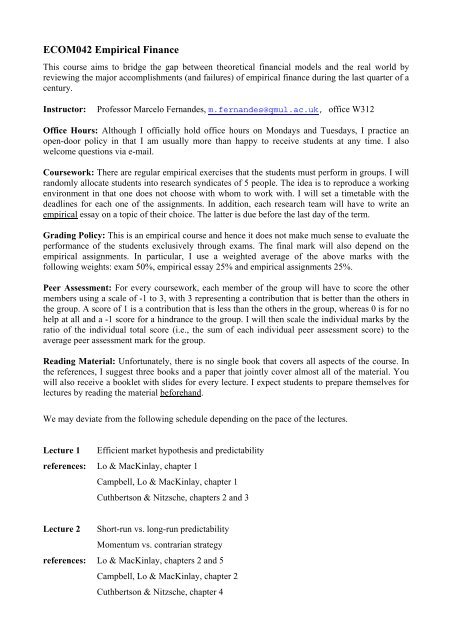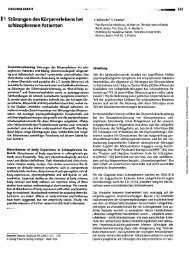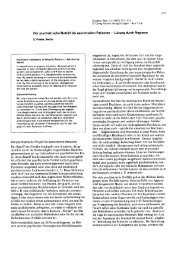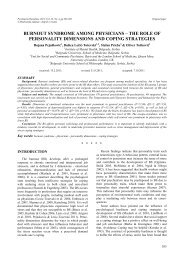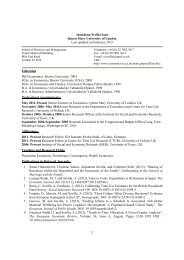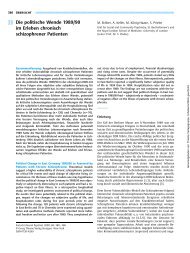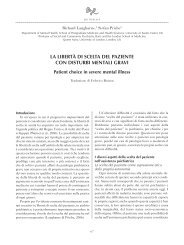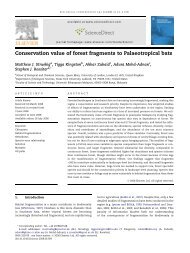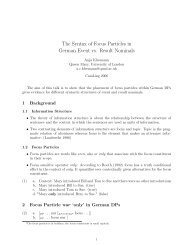ECOM042 Empirical Finance - Personal Webspace for QMUL
ECOM042 Empirical Finance - Personal Webspace for QMUL
ECOM042 Empirical Finance - Personal Webspace for QMUL
You also want an ePaper? Increase the reach of your titles
YUMPU automatically turns print PDFs into web optimized ePapers that Google loves.
<strong>ECOM042</strong> <strong>Empirical</strong> <strong>Finance</strong><br />
This course aims to bridge the gap between theoretical financial models and the real world by<br />
reviewing the major accomplishments (and failures) of empirical finance during the last quarter of a<br />
century.<br />
Instructor: Professor Marcelo Fernandes, m.fernandes@qmul.ac.uk, office W312<br />
Office Hours: Although I officially hold office hours on Mondays and Tuesdays, I practice an<br />
open-door policy in that I am usually more than happy to receive students at any time. I also<br />
welcome questions via e-mail.<br />
Coursework: There are regular empirical exercises that the students must per<strong>for</strong>m in groups. I will<br />
randomly allocate students into research syndicates of 5 people. The idea is to reproduce a working<br />
environment in that one does not choose with whom to work with. I will set a timetable with the<br />
deadlines <strong>for</strong> each one of the assignments. In addition, each research team will have to write an<br />
empirical essay on a topic of their choice. The latter is due be<strong>for</strong>e the last day of the term.<br />
Grading Policy: This is an empirical course and hence it does not make much sense to evaluate the<br />
per<strong>for</strong>mance of the students exclusively through exams. The final mark will also depend on the<br />
empirical assignments. In particular, I use a weighted average of the above marks with the<br />
following weights: exam 50%, empirical essay 25% and empirical assignments 25%.<br />
Peer Assessment: For every coursework, each member of the group will have to score the other<br />
members using a scale of -1 to 3, with 3 representing a contribution that is better than the others in<br />
the group. A score of 1 is a contribution that is less than the others in the group, whereas 0 is <strong>for</strong> no<br />
help at all and a -1 score <strong>for</strong> a hindrance to the group. I will then scale the individual marks by the<br />
ratio of the individual total score (i.e., the sum of each individual peer assessment score) to the<br />
average peer assessment mark <strong>for</strong> the group.<br />
Reading Material: Un<strong>for</strong>tunately, there is no single book that covers all aspects of the course. In<br />
the references, I suggest three books and a paper that jointly cover almost all of the material. You<br />
will also receive a booklet with slides <strong>for</strong> every lecture. I expect students to prepare themselves <strong>for</strong><br />
lectures by reading the material be<strong>for</strong>ehand.<br />
We may deviate from the following schedule depending on the pace of the lectures.<br />
Lecture 1 Efficient market hypothesis and predictability<br />
references: Lo & MacKinlay, chapter 1<br />
Campbell, Lo & MacKinlay, chapter 1<br />
Cuthbertson & Nitzsche, chapters 2 and 3<br />
Lecture 2 Short-run vs. long-run predictability<br />
Momentum vs. contrarian strategy<br />
references: Lo & MacKinlay, chapters 2 and 5<br />
Campbell, Lo & MacKinlay, chapter 2<br />
Cuthbertson & Nitzsche, chapter 4
Lecture 3 Nonsynchronous trading and bid-ask spread<br />
reference: Lo & MacKinlay, chapter 4<br />
Campbell, Lo & MacKinlay, chapter 3<br />
Lecture 4 Asymmetric in<strong>for</strong>mation<br />
reference: Easley & O’Hara (Journal of <strong>Finance</strong> 1992)<br />
Lecture 5 CAPM, APT and multifactor models<br />
reference: Lo & MacKinlay, chapter 7<br />
Campbell, Lo & MacKinlay, chapters 5 and 6<br />
Cuthbertson & Nitzsche, chapter 8<br />
Lecture 6 Fund per<strong>for</strong>mance<br />
reference: Cuthbertson & Nitzsche, chapter 9<br />
Lecture 7 Event studies<br />
reference: Cuthbertson & Nitzsche, chapter 9<br />
Campbell, Lo & MacKinlay, chapter 4<br />
Lecture 8 Present-value models<br />
reference: Campbell, Lo & MacKinlay, chapter 7<br />
Lecture 9 Term structure of interest rates<br />
reference: Cuthbertson & Nitzsche, chapters 20 to 23<br />
Campbell, Lo & MacKinlay, chapter 11<br />
Lecture 10 Volatility extraction<br />
reference: Cuthbertson & Nitzsche, chapter 29<br />
Campbell, Lo & MacKinlay, chapter 12.2<br />
References<br />
Campbell, Lo & MacKinlay (1997) The Econometrics of Financial Markets, Princeton.<br />
Cuthbertson & Nitzsche (2004) Quantitative Financial Economics, Wiley.<br />
Easley & O’Hara (1992) Journal of <strong>Finance</strong> 47, 577–604.<br />
Lo & MacKinlay (1999) A Non-Random Walk Down Wall Street, Princeton.


